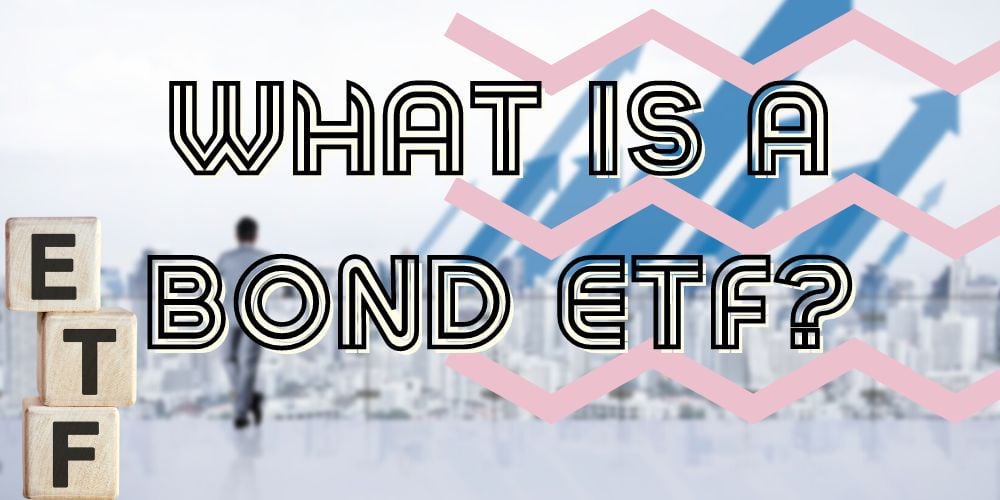Traders often look at bond markets to offer steady returns during periods of market uncertainty. Bond ETFs offer the same benefits but are more liquid, transparent, and easier to operate. Below, we explain what they are, how they work, and who they could be a good investment for.
About ETFs
Exchange-traded funds are pooled investment securities that create a portfolio of holdings based on a certain strategy.
They can deal in equities, bonds, commodities, precious metals, and other asset classes.
Most ETFs are passive in nature and simply track indexes.

Due to this reason, their expense ratios are often quite low.
The key benefits that they offer to investors is a low-effort, cost-effective, and highly liquid means to own a diversified basket of holdings.
What Is a Bond ETF?
Bond exchange-traded funds invest only in fixed-income securities (which are also known as bonds, hence the name).
Within this segment, however, they could hold individual bonds of varying types and maturities.
For example, there are ETFs focused on government bonds, corporate bonds, municipal bonds, international bonds, and even junk bonds.
Most of these bond funds are passively managed, just like their equity counterparts. They are also tradable on stock exchanges.
This is different from how actual bonds work. For this reason, bond ETFs are much easier to buy and sell.
Bond mutual funds are another asset class that hold and manage a portfolio of fixed-income assets.
However, the key differences lie in the way they trade (only through their creators) and the fact that most mutual funds are actively managed.
Are They Safer than Stocks?
Bond ETFs are lower-risk instruments than stocks in most situations.
They offer a steady yield and are unaffected by short-term macroeconomic trends or political events.
Stock market movements do not impact their value much.
Having said that, they are significantly affected by other factors, such as interest rate risk.

The value of the underlying bonds falls when interest rates rise, and vice versa.
Additionally, investors should understand that all of these funds are not equally safe.
For example, corporate bond ETFs will obviously be less risky than one that primarily carry junk bonds in their portfolio.
Types of Bond ETFs
There are two ways to categorize bond ETFs: based on the composition and the age of underlying bonds that they aim for.
Here are the main categories based on the former classification:
- Treasury Bond ETFs
- Corporate Bond ETFs
- Convertible Bond ETFs
- Floating Rate Bond ETFs
- International Bond ETFs
- Junk Bond ETFs
- Leveraged Bond ETFs
In terms of target age, there can be either short, intermediate or long-term bond ETFs.
The first variety work with bonds that have durations between one to five years.
Intermediate ones aim for a target age of five to ten years.
ETFs with average maturity ages of higher than ten years are classified as long-term.
Advantages
A bond exchange-traded fund offers many advantages when compared to owning bonds directly, such as liquidity and transparency.
Let’s understand some more of these benefits.

Diversification
Since they can hold multiple types of bonds, these funds offer instant diversification to investors.
Monthly Income
Bond ETFs pay interest on a monthly basis. Most actual fixed-income securities offer half-yearly coupons.
A regular monthly income is appreciated by certain classes of investors, such as retirees.
Liquidity
These funds are traded on stock markets, unlike bonds which are only available over the counter through brokers.
They are a lot easier to buy and sell for most retail investors.
Cost Effectiveness
Lack of liquidity can sometimes cause the bid-ask spreads in the bond market to be quite high.
An ETF, however, can get better pricing because of the size of the assets that they manage.
This benefit gets passed on to the trader who buys their shares.
Transparency
It is easy to access the holdings of an ETF at any time. It is much more transparent than a bond mutual fund.
Tax Efficiency
ETFs have very few capital gains, which means lower taxes.
Moreover, their creation and redemption process reduces the number of taxable events, also reducing the investor’s tax burden.
Disadvantages
While there is a lot going for them, here are a few things folks should understand before they opt for bond ETFs:
The Principal Is Not Guaranteed
Part of the reason why many traders invest in bonds is that their principal amount is guaranteed to be returned at maturity.
ETFs do not work this way.

Their net asset value rises and falls just like shares, so the money invested is not guaranteed to come back entirely.
Expense Ratios
An ongoing expense is charged for managing the operations of a bond fund on the investor.
This can take out a sizable portion of the interest income they generate.
Impact of Interest Rates
Rising interest rates can cause the prices of these securities to fall significantly. This is a big risk to the investor.
We explore why this happens in more detail in the next section.
What Happens to Bond ETF If Interest Rates Go Up?
Bond ETFs tend to lose value when interest rates go up because their underlying assets become less attractive.
The more long-term the funds’ targeted maturity, the bigger the loss.
Let’s understand why this happens.
When interest rates go up, newer bonds become more attractive than the older ones.
This is because they start to reflect the revised (higher) rates.
In effect, all older holdings become less valuable, which hits the value of all bond ETFs.
But there is a second impact that also comes into play.
Most bond ETFs hold a portfolio of assets with maturities that fall in a similar age range.
For example, many long-duration bond ETFs may have a target age of ten to 20 years.
When their holdings have less than this remaining to maturity, the fund has to sell them off.
Now consider what happens in a rising rate scenario.
Long-term bonds are impacted even more than short-duration ones.
This is because the latter have fewer interest payments left, and therefore the loss to investors is lesser in them.
Hence for long-duration ETFs, there is a double whammy in their value.
How Long Do You Need to Hold a Bond ETF?
There is no minimum holding period on bond ETFs.
They are available to buy and sell over a stock exchange, just like other shares.
Folks can make intraday trades, short-sell, and even do margin trades with them.
Due to this reason, they are much more liquid than actual bonds. For most investors, dealing with these funds is much easier.
Can You Lose Money on Bond ETFs?
Yes, bond ETFs can also lose money.
As explained earlier – they are negatively impacted when interest rates rise.
Since their underlying assets become less valuable, it is natural that their value also declines.
Surprisingly, actual bonds can fare better than ETFs in such a scenario.
This is because they guarantee returning the premium at maturity.
An investor can just hold on to the bond until it ages and weather out rising interest rates.
But ETFs have to keep selling out older bonds and buy new ones regularly to maintain a target age.
Hence their prices can fall much more.
Is It a Good Investment?
For folks who want a steady, monthly income but are not looking for superlative capital growth, bond ETFs could be an excellent investment.
It is a low-risk, low-return asset class, just like dividend stocks.
However, as explained earlier – they can lose their value swiftly in a rising rate environment.
Apart from this, they offer several advantages over buying actual bonds.
Their high liquidity, transparency, and easy operability make them a better choice for most retail investors than actual bonds.
However, the lack of a premium guarantee and fixed coupon rates are things that investors should keep in mind.
Final Thoughts
Bond ETFs combine all the ease of use and liquidity of exchange-traded funds with the stability of the bond market.
They can be an excellent asset class to diversify a portfolio, especially as a hedge against market downturns.
Their regular income and low expense ratios are also very enticing for traders.
However, before investing, it is important to understand some of the risks involved with these funds.
For one thing, their returns can be severely impacted during periods of rising interest rates.
Moreover, unlike bonds, ETFs do not guarantee that the principal amount will come back.
Again, not all bond ETFs are safe. For example, those that trade in investment-grade bonds will be less risky than ones dealing in junk bonds.
Before opting, investors should do their due diligence and analyze the performance of the ETF they want to opt for.


 Tags:
Tags:










